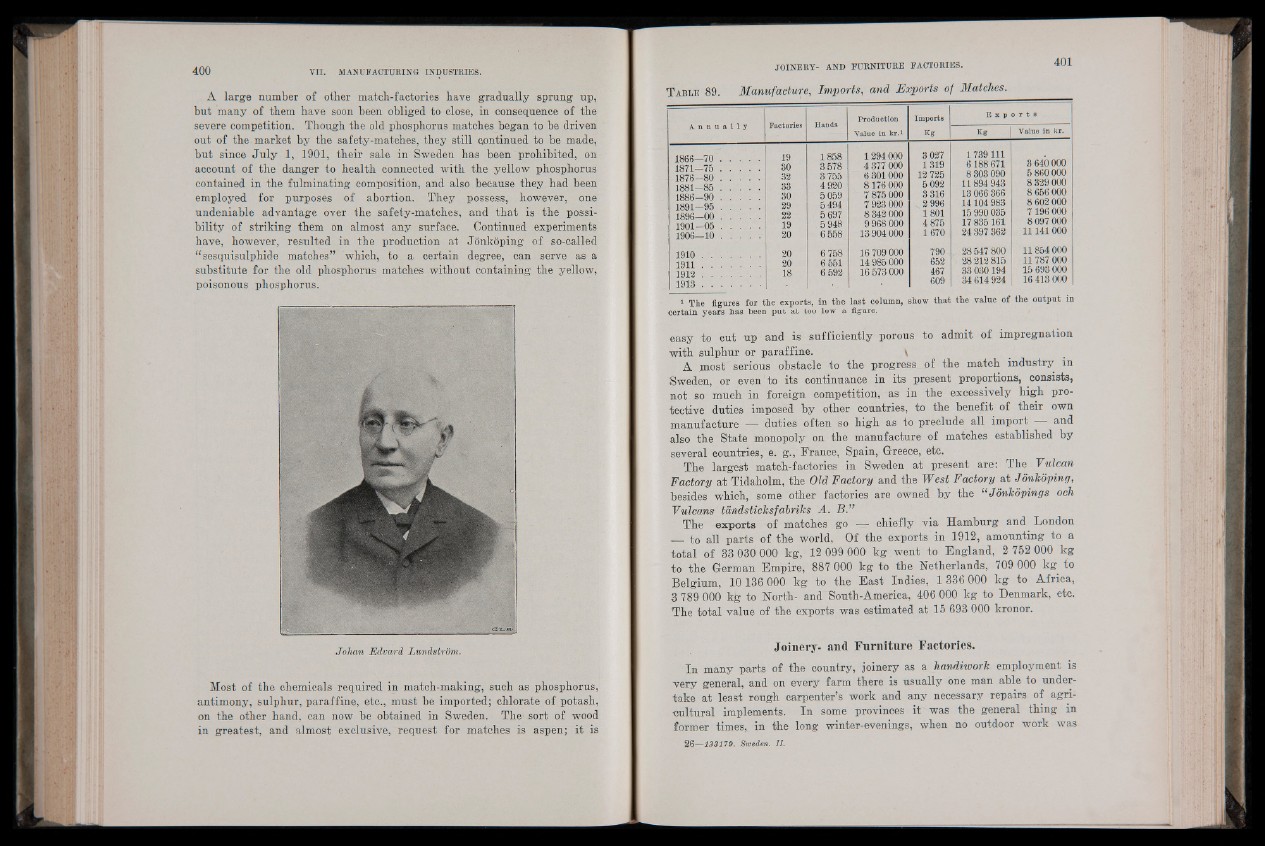
A large number of other match-factories have gradually sprung up,
but many of them have soon been obliged to close, in consequence of the
severe competition. Though the old phosphorus matches began to be driven
out of the market by the safety-matches, they still continued to be made,
but since July 1, 1901, their sale in Sweden has been prohibited, on
account of the danger to health connected with the yellow phosphorus
contained in the fulminating composition, and also because they had been
employed for purposes of abortion. They possess, however, one
undeniable advantage over the safety-matches, and that is the possibility
of striking them on almost any surface. Continued experiments
have, however, resulted in the production at Jonkoping of so-called
“ sesquisulphide matches” which, to a certain degree, can serve as a
substitute for the old phosphorus matches without containing the yellow,
poisonous phosphorus.
Johan Edvard, Lundström.
Most of the chemicals required in match-making, such as phosphorus,
antimony, sulphur, paraffine, etc., must be imported; chlorate of potash,
on the other hand, can now be obtained in Sweden. The> sort of wood
in greatest, and almost exclusive, request for matches is aspen; it is
Table 89. Manufacture, Imports, and Exports of Matches.
A n n u a l l y Factories Hands
Production
Yalue in kr.i
Imports
Kg
E x p o r t s
Kg Value in kr.
1866 70 ................ 19 1858 1294000 3 027 1 739 111
1871 75 80 3 578 4 377 000 1319 6188 671 3 640 000
1876 80 32 3 755 6 301000 12 725 8 303 090 5 860 000
1881 85 33 4 920 8176 000 5 092 11894 943 8 329 000
1886 90 30 5 059 7 875 000 3 316 13 066 366 8 656 000
1891 95 29 5494 7 923 000 2 996 14 104 983 8 602 000
1896 00 . 22 5 697 8 342 000 1801 15 990 035 7196 000
1901 05 ................ 19 5948 9 968 000 4875 17 835161 8 097 000
1906—10 ................ 20 6 558 13 904 000 1670 24397 362 11141000
1910 20 6 758 16 709 000 790 28 547 800 11854000
1911 20 6 551 14 985 000 652 28 212 815 11787 000
1912 18 6 592 16 573 000 467 33 030 194 15 693 000
1 9 1 3 ........................ 609 34 614 924 16 413 000
1 The figures for the exports, in the last column, show that the value of the output in
certain years has been put at too low a figure.
easy to cut up and is sufficiently porous to admit of impregnation
with sulphur or paraffine. \
A most serious obstacle to the progress of the match industry in
Sweden, or even1 to its continuance in its present proportions, consists,
not so much in foreign competition, as in the excessively high protective
duties imposed by other countries, to the benefit of their own
manufacture — duties often so high as to preclude all import —* and
also the State monopoly on the manufacture of matches established by
several countries, e. g., France, Spain, Greece, etc.
The largest match-factories in Sweden at present are: The Vulcan
Factory at Tidaholm, the Old Factory and the West Factory at Jonkoping,
besides which, some other factories are owned by the “ Jonkopings och
Vulcans tandsticksfabriks A. B.”
The exports of matches go — chiefly via Hamburg and London
■ to all parts of the world, Of the exports in 1912, amounting to a
total of 33 030 000 kg, 12 099 000 kg went to England, 2 752 000 kg
to the German Empire, 887 000 kg to the Netherlands, 709 000 kg to
Belgium, 10 136 000 kg to the East Indies, 1336 000 kg to Africa,
3 789 000 kg to North- and South-America, 406 000 kg to Denmark, etc.
The total value of the exports was estimated at 15 693 000 kronor.
Joinery- and Fnrniture Factories.
In many parts of the country, joinery as a handiwork employment is
-very general, and on every farm there is usually one man able to undertake
at least rough carpenter’s work and any necessary repairs of agricultural
implements. In some provinces it was the general thing in
former times, in the long winter-evenings, when no outdoor work was
26—133179. Sweden. 11.